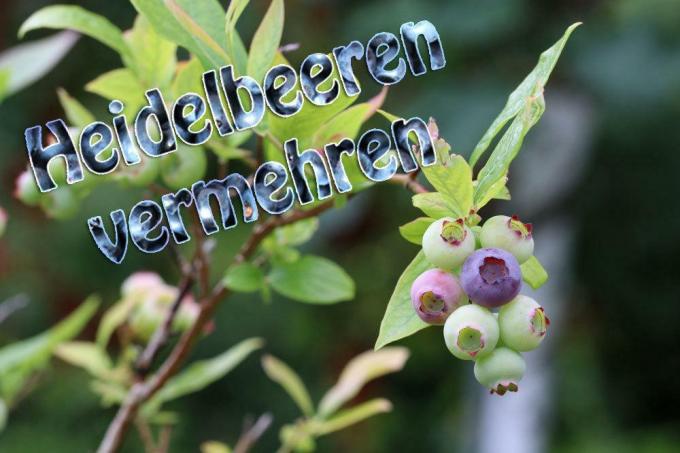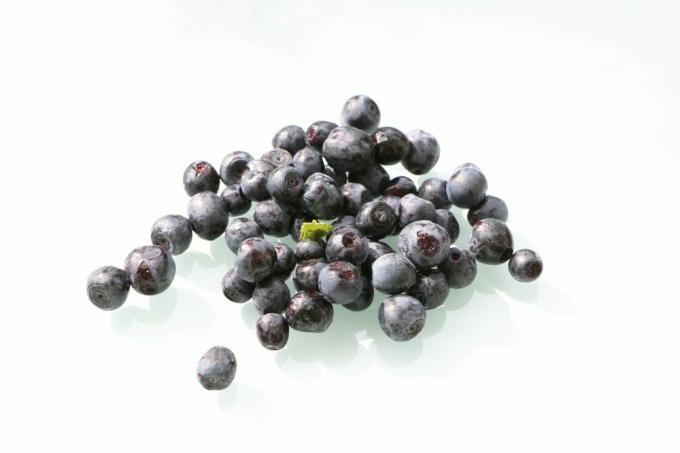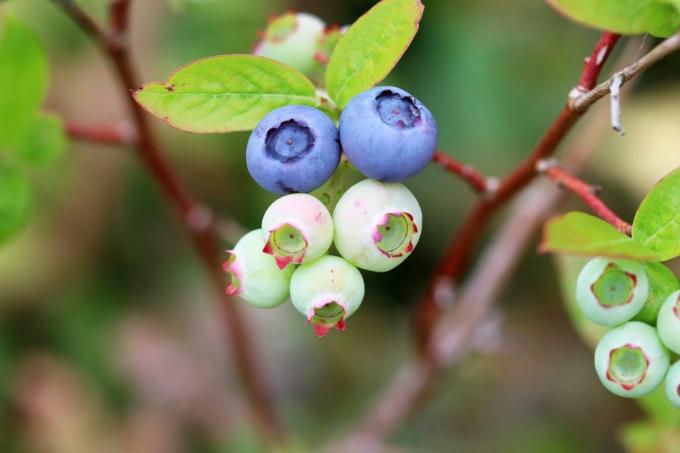
table of contents
- Type of propagation
- Offshoots and cuttings
- Seeds
- time
- Soil conditions
- Propagating blueberries: instructions
- Cuttings
- Offshoot
- Seeds
Fresh berries from our own cultivation are always a pleasure. In order to be able to harvest plenty of blueberries from the garden, good care is a prerequisite. There are even more blueberries when the number of plants increases. This is done by propagating with seeds, cuttings and cuttings and the following professional instructions from the plant magazine with expert tips on the subject "Propagate blueberries".
Type of propagation
Offshoots and cuttings
The best way of propagating depends primarily on whether you have your own blueberry plants (Vaccinium myrtillus) are available or access to them, for example, from neighbors or friends consists. Here it is advisable to use cuttings or offshoots for propagation, especially since they prove to be the most promising propagation options. They are also the fastest way to grow a blueberry bush.
Seeds
Seeds can also be obtained from an existing one (Vaccinium myrtillus) or obtained from specialist retailers. Propagation by seeds takes significantly longer than by cuttings and cuttings, because it takes a lot of time from germination to growth. In addition, seeds generally carry a higher risk of non-germination. For those who don't have a shrub nearby, however, this is the only way of propagation, es unless a full-grown plant is bought in stores from the outset, but it is relatively expensive is.
time
Propagation with cuttings
This type of propagation is ideal with new shoots (cuttings) that are already slightly woody. Usually it is between June and August the case.
Additionally, be sure to choose a warmer but overcast day for pruning and planting. This prevents the shoots from wilting too much. Because that would reduce the chance that a new plant will grow from a cutting.
Propagation with offshoots
It often takes up to a year for the offshoots of blueberries to form firm roots. It is optimal to use the growing season from spring to late summer and accordingly to pull an offshoot in the spring to start. So there is a good chance that a separate young plant has emerged in the following spring.
Propagation with seeds
Sowing seeds can be done both in spring and in autumn. Autumn is ideal when the seeds are extracted from the fresh fruits after the last harvest. That way, they don't have to be stored until spring, which can drastically reduce the chances of germination. For sowing in spring, seeds bought from specialist shops are best suited.
Soil conditions
Regardless of whether you choose cuttings, offshoots or seeds, when planting, make sure that the soil meets certain conditions. With seeds you should use a special potting soil, while with cuttings and offshoots the claim sometimes goes in a different direction.
Soil for propagation of cuttings and cuttings
- Loose and permeable
- Lime-free
- Rich in nutrients and humus
- High moisture content
- pH between 4.0 and 5.0
- Acid bog soil is best suited
Soil for seed propagation
- Low in nutrients and humus
- Loose and well permeable to water
- Slightly sandy or loamy for improved moisture retention
- pH between 4.5 and 5.8
tip: The condition of soils can be determined easily and without much effort using specific test strips. They are available relatively cheaply from specialist gardeners.
Propagating blueberries: instructions
Cuttings
Materials needed
- Secateurs
- Medium-sized flower pot with a drainage hole
- Translucent plastic film
- Suitable soil - bog soil is ideal
- One to two handfuls of gravel or quartz sand for drainage
- Three to four wooden sticks (three times as high as the shoots)
- water
preparation
- Lay out the bottom of the pot with around two centimeters of quartz sand or gravel as drainage
- Then fill in suitable soil
- Distance to the edge of the pot between two and three centimeters
- Moisten the soil well
Cut cutting
- Look for two to five new shoots from the current year that are semi-hard and lignified
- Cut off five to eight inches long
- Separate fresh tips from shoots with soft tissue
- Lower section below a bud with a leaf
- Upper cut between three and five centimeters above the leaf / bud
- Remove the bottom two to three leaves
Planting instructions
- Put the leaves of the cuttings in the soil at regular intervals
- Should be about three to four centimeters in soil
- Press the soil firmly around the shoots
- Moisten the soil well again without provoking waterlogging
- Spread some sticks around the edge of the pot and stick them in the ground
- If the soil is slightly dry, place translucent plastic film over the outer bars
- Cuttings are completely surrounded by the film
- The height distance between the film and the cuttings should be at least three times the height of the plants
- Ventilate the foil for 20 minutes a day and re-water the soil if necessary
- Location: bright, sunny and warm - ideally on a window sill flooded with light
- Root formation: between two and three months
After rooting
It is easy to find out whether roots have formed using the plucking test: pull gently on the cutting - if there is resistance, roots have grown. This is the moment when further action should be taken:
- remove foil
- Plants remain planted
- For wintering, put young plants in a cool place down to -5 ° C
- Get used to higher temperatures in spring
- Plant in a larger pot or in a garden or bog bed in June at the earliest
Offshoot
Propagation with offshoots is often used, although a little luck and a lot of patience are required. Older specimens of the Vaccinium myrtillus are best suited for an offshoot. Find a thinner, pliable, ideally annual shoot that is close to the ground.
Instructions for cuttings growth
- Loosen the soil well along the shoot close to the ground
- Shovel a "trench" about five centimeters deep into which the shoot is pressed
- The tip of the shoot should look out of the “ditch”
- Close “dig” with shoot again with the excavated earth
- To weigh down the shoot, place a stone or similar on the entry point (prevents the shoot from pushing out)
- Alternatively, the shoot can be fixed with cut forks
- Waiting time for roots to form: up to a year
tip: Offshoots can also be grown from a pot blueberry. To do this, a second pot of soil is placed directly next to the potted plant and a shoot is sunk into the soil. The procedure is the same as described above.
Separate offshoots
If a branch with roots has developed from the lowered shoot of the blueberries, it can be separated from the mother plant. The cut must be made in such a way that no parts of the root are damaged. Once the separation has taken place, the offshoot is to be planted as described below:
- Fill the bottom of the planter about two centimeters with a drainage layer made of gravel, pottery shards or quartz sand
- Half of the pot should be filled with suitable soil, ideally with peat earth, and moistened
- Wait a moment for the earth to dry slightly (This is how the earth settles)
- Position the young plant in the middle of the pot (roots must not kink)
- Fill up with soil again until the plant stem is two to three centimeters below the surface of the earth
- Lightly press the soil down to give the plant stability
- Pour moderately
- Location: warm, bright to sunny, preferably full sun, but no direct sunlight
- The young plant should not spend the first winter outdoors - after that it can be planted outside
Seeds
Blueberries multiply in the wild in large numbers, so that they can also be cultivated in your own garden. If you would like to purchase the seeds from specialist retailers, there is hardly a description of which blueberry type / variety it is. If you want to be sure that only certain varieties will grow, you should take the seeds from fresh berries of which you are familiar with the variety. It works in the following way:
- Cut the berry open all around with a very sharp knife or razor blade
- Carefully remove the seeds with a pair of tweezers
- Alternatively, the seeds can be squeezed out of the fruit
- Put the seeds in a close-meshed sieve (a tea strainer is best for this)
- Rinse under a jet of water to remove any remaining pulp
- Lay out on kitchen paper and allow to dry
Instructions for sowing
- Fill a plant container such as a pot or a seed tray with potting soil
- An old plastic fruit packaging with a lid, in which air holes are pierced, is also ideal
- The seeds are then distributed on the potting soil
- Under no circumstances press the seeds into the soil and / or cover them with soil (light germs)
- Pour earth
- Stretch the transparent plastic film with small air holes over the seeds
- Open the foil regularly for a few minutes and moisten the soil
- Location: bright and sunny, but not too hot or direct sunlight
- Germination: after a few days
- The first shoots are usually visible after two to three weeks
- Roots can take up to six months to appear
- Prick out as soon as the young plant has reached a height of around 15 centimeters





